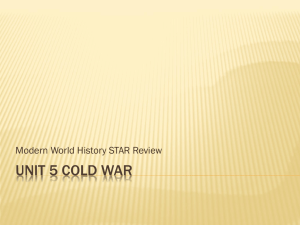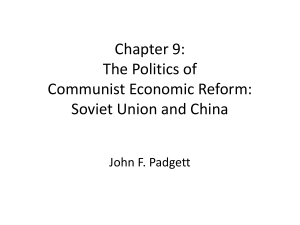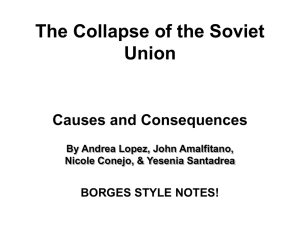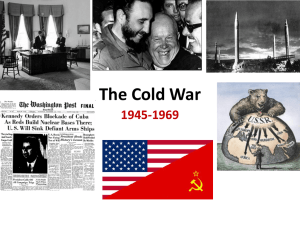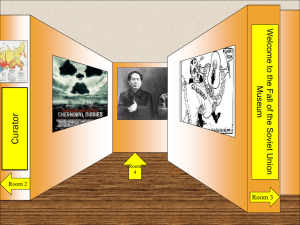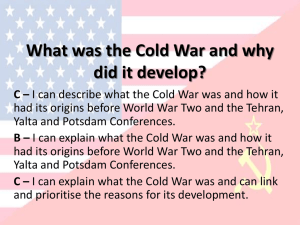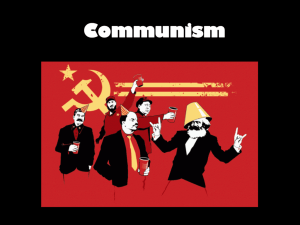Reasons of the collapse of the Soviet Union
advertisement
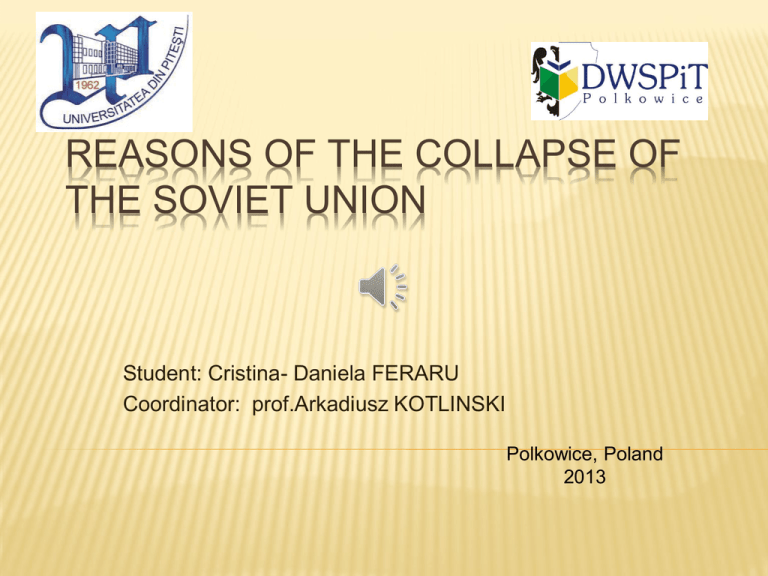
REASONS OF THE COLLAPSE OF THE SOVIET UNION Student: Cristina- Daniela FERARU Coordinator: prof.Arkadiusz KOTLINSKI Polkowice, Poland 2013 INTRODUCTION On Christmas Day 1991, the Soviet flag flew over the Kremlin in Moscow for the last time. A few days earlier, representatives from 11 Soviet republics (Ukraine, the Russian Federation, Belarus, Armenia, Azerbaijan, Kazakhstan, Kyrgyzstan, Moldova, Turkmenistan, Tajikistan and Uzbekistan) met in the Kazakh city of Alma-Ata and announced that they would no longer be part of the Soviet Union. The USSR officially ceased to exist on 31 December1991. The collapse of the Soviet Union in December 1991 changed the world’s geopolitical balance. When the Soviet Union fell, it ended the tenure of a superpower with the resources of more than a dozen countries. The fall left its largest component, Russia, unable to wield anything like the global clout that the Soviet Union had for decades. The concluding drama of the Cold War -- the collapse of communism in the Soviet Union and Eastern Europe and the end of the fourdecade-old East-West conflict -- unfolded in three acts between 1989 and 1991. CAUSES OF SOVIET COLLAPSE: Stagnating Economy Afghanistan Quagmire Perestroika Decentralization Glasnost Cherynobyl Disaster Local Nationalism Excessive Military Focus Reduced Motivation of Fear Ethnic Fragmentation STAGNATING ECONOMY The Soviet Union had grown to a size large enough to the point where it became cumbersome to continue state planning. The massive and intricate Soviet economy became too large to manage by state planners, who were unwilling to enable more autonomy at mid-managerial level to remain responsive down to a localized level. This resulted in failed economic policies (failure to respond timely to continuous changes), while thwarting innovation. Managers commonly fudged numbers to show that quotas and goals were being met. After a decade of over-inflated military expenditures, dwindling oil revenue, and a centrally-planned economy that was too rigid to adapt to consumer demands, Mikhail Gorbachev, upon assuming office, declared the Soviet economy to be in a "pre-crisis." Gorbachev immediately transformed the face of Soviet politics. After reforming the government, Gorbachev set out to reform the economy and ultimately, Soviet society. Gorbachev's economic reforms ( perestroika, or restructuring), were perceived as noble, but poorly executed. Gorbachev intended glasnost to strengthen the communist regime, he did not initiate a crack-down when Soviet citizens went beyond the original intent of glasnost. Soviet intellectuals began questioning the very tenets of Soviet Communism and attacked the Communist Party in newspapers, journals, film, and books. Eastern European thinkers followed the lead of their Soviet counterparts. Consequently, glasnost had the unintended effect of spurring nationalist and anti-communist movements in Eastern Europe and the Soviet republics. Dissidents in Poland, East Germany, Czechoslovakia, and other Soviet-satellite states staged labor demonstrations. Citizens took to the streets, demanding that the Communist Party step aside and allow democratic elections. In February, 1990, the Communist Party agreed to relinquish its political monopoly. Many of the civic groups that had been voicing displeasure with the Soviet system formed political parties. Most of these new parties, especially those outside of Russia had a nationalist agenda. Within a month, the Baltic republic of Lithuania declared itself an independent state. Other Soviet republics quickly followed. AFGHANISTAN QUAGMIRE The Soviet-friendly Afghan government was threatened by anti-communist insurgents, which grew to outnumber the Afghanistan army. The USSR supplied tens of thousands of troops and war machines. However, support transformed into an invasion followed by occupation of various cities and towns, bogging the Soviets down into a guerilla war with an increasingly growing and zealous Afghan resistance movement. By the time of the Soviet withdrawal from 1987- 89, nothing concrete had been gained, and the USSR left damaged and humiliated. PERESTROIKA Gorbachev brought perestroika to the Soviet Union's foreign economic sectorin 1987 with measures that the country's economists considered bold at that time. His program virtually eliminated the monopoly that the Ministry of Foreign Trade had once held on most trade operations. It permitted the ministries of the various industrial and agricultural branches to conduct foreign trade in sectors under their responsibility rather than having to operate indirectly through the bureaucracy of trade ministry organizations. In addition, regional and local organizations and individual state enterprises were permitted to conduct foreign trade. Some free market elements were added, but not enough to bring about reform. The free-market policies were enough to result in failed businesses, but shortages became common as price controls were kept in place. With price ceilings limiting profits, the incentive to produce sufficient quantities was removed. The changes to foreign policy were among the most productive steps Gorbachev took. They included improving relations with the US, adapting a policy of non-intervention in Central and Eastern Europe and talking about nuclear non-proliferation with his American counterpart. According to the man himself, they were not easy steps – but they were possible because perestroika had already begun. The move also allowed private business ownership, something that hadn't been allowed in decades. Together with the idea of glasnost, or openness, which shone a light on the country's problems and allowed greater media freedom, the two words and the ideas behind them captured the hearts and minds of millions of Soviet people. But the reality of those changes were, perhaps, a little disappointing. What most people remember about those days, after the excitement of the planned changes died down, are the empty shelves in food stores, the day-long queues for a little butter, some sugar or cheap and not very fresh fish. Many argued that Gorbachev's reforms were too slow, too mild, that more radical measures were needed to lift the country out of its economic slump. As Time Magazine wrote at the time, Gorbachev's promises were "good talk with no goods." GLASNOST Glasnost was the official Soviet governmental policy of openness and transparency implemented in the mid-1980s. It allowed for honesty in discussing the problems and shortcomings of the country, and for consultation in the governing and leadership of the U.S.S.R. Glasnost, which can mean "publicity," encouraged a dissemination of information and was initiated by Mikhail Gorbachev in 1985 as a part of his emerging perestroika policy. It was used by Gorbachev to reduce corruption among the Communist leaders of the Soviet government and to curtail the censorship that was characteristic of Communist rule. With the Soviet public becoming more disenchanted with their secretive government, Gorbachev attempted to compensate by committing to openness and transparency with the media. However, this backfired as the public learned of long-standing political cover ups revealing past and recent atrocities, missteps by leadership, social and health failures of the USSR and the true extent of national economic problems. This further eroded support for the regime. CHERYNOBYL DISASTER It was the nuclear power plant accident in the Ukraine town of Cherynobyl. It was initially covered up by the Soviet government, compounding the health crisis, while further sowing the seeds of distrust within the constituency, as the extent of the disaster and the cover-up came to light. The accident caused the largest uncontrolled radioactive release into the environment ever recorded for any civilian operation, and large quantities of radioactive substances were released into the air for about 10 days. This caused serious social and economic disruption for large populations in Belarus, Russia and Ukraine. Two radionuclides, the short-lived iodine-131 and the long-lived caesium-137, were particularly significant for the radiation dose they delivered to members of the public. Several organisations have reported on the impacts of the Chernobyl accident, but all have had problems assessing the significance of their observations because of the lack of reliable public health information before 1986. LOCAL NATIONALISM With declining public perception of the Soviet government (due to political blunders), nationalism grew within each of the individual republics, creating independence ambitions in republics such as Ukraine, Belarus, Estonia, Latvia and Lithuania. Nationalism was pursued to a different extent in each area. In the Baltic republics, the claim for independence had always been strongest as these areas had been forcibly incorporated into the USSR only in 1940, which followed after they were secured in the War by mass deportations possibly amounting to over a tenth of the regions population. The area saw mass Russian immigration during the post-war years and fears of the peril from the East abounded among the indigenous population. Moreover, despite political, religious (the Roman Catholic Lithuanians and Protestant Latvians and Estonians suffered the same religious persecutions under Khruschëv as other denominations) and cultural repression, in economic terms the Balts were the wealthiest peoples in the USSR, better off even than the Russians themselves, with none of the economic grounds for remaining in the Union which applied in the Caucasus or Central Asia. The Baltics provided the model for other regions, with the Popular Fronts, notably in Lithuania, providing the model for mass independence movements in other regions. EXCESSIVE MILITARY FOCUS The USSR was overly-focused on military build-up, neglecting domestic troubles that would play a major role in bringing down the USSR. This was largely due to the perceived need to keep pace with the massive U.S. military build up. REDUCED MOTIVATION OF FEAR Friendlier relations with the U.S. in the 70s, 80s meant that the general public was no longer completely motivated to strengthen itself against the American threat. Beginning in the early 1970s, the Soviet regime proclaimed a policy of detente and sought increased economic cooperation and disarmament negotiations with the West. However, the Soviet stance on human rights and its invasion of Afghanistan in 1979 created new tensions between the two countries. These tensions continued to exist until the dramatic democratic changes of 1989-91 led to the collapse during this past year of the Communist system and opened the way for an unprecedented new friendship between the United States and Russia, as well as the other new nations of the former Soviet Union. ETHNIC FRAGMENTATION The USSR used “Slav Nation/Pride” propaganda as justification in creating a unified Slav state. However, Russia was clearly the favored and dominant state, while others (including Turkish/Central Asian constituents) were oppressed. Russians clearly viewed themselves as superior, despite asking client states to buy into Slav unity/patriotism/pride, which became a transparent effort to draw other Slav nations in under a false romantic ideal. As a result, non-Russians were quick to separate from the Soviet Union when it entered troubled waters. Mobilization and claims for autonomy threatened not only the central state but also those local populations - especially Russians - who had strong investments in the central state. Other ethnic rivalries, such as the enmity of Azerbaijanis and Armenians, also intensified. But the crucial conflicts set Estonians, Georgians, and their counterparts elsewhere against both the central state and its local defenders. A spiral began: the more ethnic groups challenged the state with relative impunity, the more other ethnic groups felt emboldened to challenge the state. The conflict became even more acute where (as in the Baltic states) local majorities declared their legislative institutions autono- mous and started to organize independent military forces. The economic weakening of the central government surely signaled its vulnerability to nationalist demands, and may even have stimulated them, either by making union with the center less attractive in economic terms, or by imposing burdens on peripheral populations that added to their grievances. US INFLUENCE The United States of America manipulated the USSR economic system through sabotage and other negative activities towards the state and its economy, creating cracks . In 1982, US president Ronald Reagan approved a CIA plan to sabotage the Soviet Union's economy through covert transfers of technology that contained hidden malfunctions, including software that later triggered a huge explosion in a gas pipeline, according to a former White House official. At the time, the US was attempting to block Western Europe from importing Soviet natural gas. There were also signs that the Soviets were trying to steal a wide variety of Western technology. Then, a KGB insider revealed the specific shopping list and the CIA slipped the flawed software to the Soviets in a way they would not detect it. The sabotage of the gas pipeline has not been previously disclosed, and at the time was a closely guarded secret. The role that Reagan and the US played in the collapse of the Soviet Union is still a matter of debate. Some argue that US policy was the key factor; others say that internal Soviet factors were more important, including economic decline and President Mikhail Gorbachev's revolutionary policies of glasnost and perestroika. LOSS OF SATELLITE ECONOMIES Growing dissatisfaction among the countries of Eastern Europe (and the fall of puppet regimes) meant that the USSR could not exploit those resources to prop up the union. This led to the dissolution of the Warsaw Pact beginning in 1989. The central government was then increasingly pressured by nationalist movements in the Ukraine, Caucasus, Georgia and outlying Asian states. In 1975 all European states, except Albaniasigned the Helsinki Accods.The countries that signed also pledges to respect human rights and to cooperate in economic and scientific matters. The problems between the satellite countries escalated until communism was finally crushed.In 1991, communism fell in the Soviet Union, ending the feuds between the satellite states and the U.S.S.R. CONCLUSION The collapse of the Union of Socialist Soviet Republics radically changed the world's economic and political environment. No other conflict of interest dominated the post World War Two world like the cold war did. One man is credited with ending the cold war, Mikhail Gorbachev. This however was not the biggest event Gorbachev was responsible for. The end of the cold war was just a by-product of the other major event he was involved with. That is the fall of communism in the USSR and the collapse of the USSR itself. The collapse of the USSR caused Gorbachev to resign as President of the Soviet Union on the 25th of December, 1991. His successor, Boris Yeltsin took steps to adopt a fully functioning market economy. This went beyond Gorbachev’s economic reform policy of perestroika, it meant Russia was no longer communist. This marked the collapse of communism, the end of the Cold War, and the beginning of the modern unipolar world order. BIBLIORGPHY http://wiki.answers.com/Q/What_were_the_causes_of_the_collapse_of_the_Soviet_Uni on http://sfr-21.org/collapse.html http://iis-db.stanford.edu/pubs/22468/No_108_StonerWeiss_domestic_and_international_influences_on_collapse_of_USSR.pdf http://www.coldwar.org/articles/90s/fall_of_the_soviet_union.asp http://www.history.com/topics/fall-of-soviet-union http://rt.com/news/soviet-union-gorbachev-perestroika-799/ http://www.faqs.org/espionage/Co-Cop/Cold-War-1972-1989-the-Collapse-of-theSoviet-Union.html http://www.world-nuclear.org/info/Safety-and-Security/Safety-of-Plants/ChernobylAccident/#.UcLTOPkwdRU http://gi0rtn.tripod.com/essays/reveeu4.html http://www.theage.com.au/articles/2004/02/27/1077676960916.html
